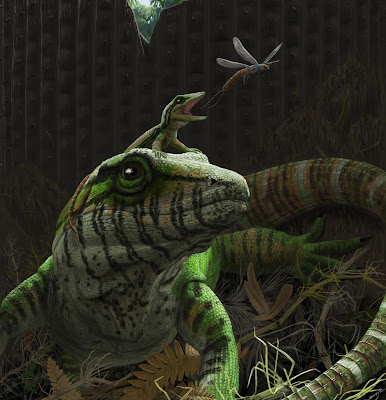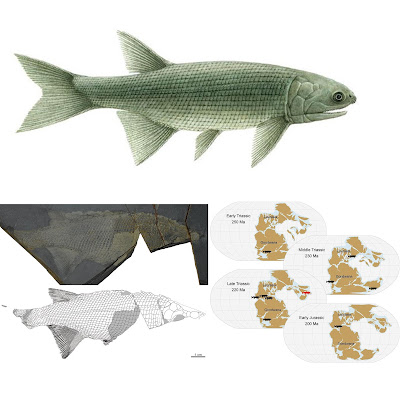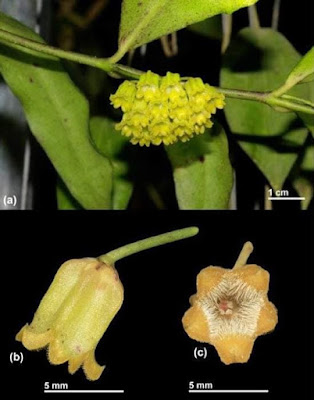[Most Recent Entries] [Calendar View]
Tuesday, December 24th, 2019
| Time | Event | ||
| 7:37a | [Paleontology • 2020] Dendromaia unamakiensis • Varanopid from the Carboniferous of Nova Scotia reveals Evidence of Parental Care in Amniotes
Abstract Here we report on a fossil synapsid, Dendromaia unamakiensis gen. et sp. nov., from the Carboniferous period of Nova Scotia that displays evidence of parental care—approximately 40 million years earlier than the previous earliest record based on a varanopid from the Guadalupian (middle Permian) period of South Africa. The specimen, consisting of an adult and associated conspecific juvenile, is also identified as a varanopid suggesting parental care is more deeply rooted within this clade and evolved very close to the origin of Synapsida and Amniota in general. This specimen adds to growing evidence that parental care was more widespread among Palaeozoic synapsids than previously thought and further provides data permitting the identification of potential ontogeny-dependent traits within varanopids, the implications of which impact recent competing hypotheses of the phylogenetic affinities of the group. Dendromaia unamakiensis gen. et sp. nov. Hillary C. Maddin, Arjan Mann and Brian Hebert. 2020. Varanopid from the Carboniferous of Nova Scotia reveals Evidence of Parental Care in Amniotes. Nature Ecology & Evolution. 4; 50–56. DOI: 10.1038/s41559-019-1030-z | ||
| 8:55a | [PaleoIchthyology • 2020] Hiascoactinus boryeongensis • The First Record of Redfieldiiform Fish (Actinopterygii) from the Upper Triassic of Korea: Implications for Paleobiology and Paleobiogeography of Redfieldiiformes
Highlights: • The first report of redfieldiiform fish from Asia.• Hiascoactinus boryeongensis gen. & sp. nov. was proposed. • A definite paleontological evidence that Pangea was a continuous land from Gondwana to the easternmost end of East Asia during the Late Triassic through terrestrial water systems. Abstract A new genus and species of redfieldiiform fish, Hiascoactinus boryeongensis gen. et sp. nov., is described based on a nearly complete specimen from the Upper Triassic Amisan Formation of South Korea. Hiascoactinus is distinguished from other redfieldiiforms by having a barely ornamented dermal skull surface except for the snout region, two heteromorphic suborbitals arranged vertically behind the postorbital, a pistol-shaped suprascapular, and dorsal and anal fins with divided fin membranes between rays. The morphological features of the snout region and dorsal and anal fins of Hiascoactinus provide important clues to understand its feeding and swimming behavior. All previously proposed Asian redfieldiiform fossils are inaccurately classified, and consequently, Hiascoactinus is regarded as the only valid redfieldiiform taxon in Asia. Hiascoactinus is assigned to the basal group of redfieldiiforms primarily based on the presence of an antopercle. The basal phylogenetic position of Hiascoactinus indicates that basal redfieldiiforms dispersed from the southern Gondwanaland to the easternmost Laurasia through the terrestrial water system, and these two landmasses were connected during the Late Triassic. Su-Hwan Kim, Yuong-Nam Lee, Jin-Young Park, Sungjin Lee and Hang-Jae Lee. 2020. The First Record of Redfieldiiform Fish (Actinopterygii) from the Upper Triassic of Korea: Implications for Paleobiology and Paleobiogeography of Redfieldiiformes. Gondwana Research. In Press. DOI: 10.1016/j.gr.2019.11.008 | ||
| 9:15a | [Botany • 2019] Hoya amicabilis (Apocynaceae: Asclepiadoideae) • A New Species from Java discovered on Facebook
Abstract A new species from Java, Hoya amicabilis S.Rahayu & Rodda is described and illustrated. It was first identified as a new species from pictures posted on social media in 2017. Hoya amicabilis is part of a small group of species that have an unusual shrubby habit, but it is the only one in that group with bright yellow campanulate flowers. Furthermore, Hoya amicabilis is a rather unusual species of Hoya since its staminal corona lobes are oblong, erect, while most species of Hoya have well‐developed generally spreading corona lobes, and its style head is umbonate, brightly coloured and extending above the anther appendages, while most species have a conical style head covered by anther appendages. Keywords: Apocynaceae, Asclepiadoideae, Marsdenieae Hoya amicabilis S.Rahayu & Rodda sp. nov. Etymology: Hoya amicabilis is named after social media (Latin amicabiliter interventus) that are a growing aid to scientists in discovering new species. Sri Rahayu and Michele Rodda. 2019. Hoya amicabilis sp. nov. (Apocynaceae, Asclepiadoideae), from Java discovered on Facebook. Nordic Journal of Botany. 37(12) DOI: 10.1111/njb.02563 |
| << Previous Day |
2019/12/24 [Calendar] |
Next Day >> |












